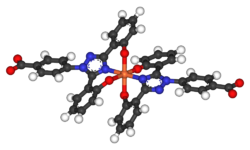Cardiovascular disease
Chelation therapy for heart disease began in the 1950s after anecdotal reports that people treated with chelation for heavy metal poisoning had experienced an unexpected relief from symptoms of angina. [25] In the 1980s-2000s, its practitioners estimated that between 100,000 and 200,000 Americans per year were undergoing chelation therapy for heart disease, at a cost of about $5,000 per course of treatment. [26] [27]
The American College of Cardiology and the Mayo Clinic do not currently endorse chelation therapy for heart disease. [28] [29] However, a large-scale clinical study published in 2012 did find a modest benefit from chelation therapy in improving outcomes for patients with a prior heart attack. [27]
In the 1990s and early 2000s, the weight of scientific evidence was against any benefit of chelation therapy for heart disease. [30] [31]
In 1998, the U.S. Federal Trade Commission (FTC) even charged a chelation-advocacy group, the so-called American College for Advancement in Medicine (ACAM), with making false or unsubstantiated claims when they promoted chelation therapy for heart disease on their website and on a brochure they published. In December 1998, the FTC announced that it had secured a consent agreement barring ACAM from making claims that chelation therapy is effective against atherosclerosis or any other disease of the circulatory system. [32] [33]
However, in 2003-2012, the National Institutes of Health (NIH) sponsored a $30 million controlled trial of chelation therapy, conducted by their National Center for Complementary and Alternative Medicine (NCCAM). This was known as the Trial to Assess Chelation Therapy or TACT. In contrast to prior controlled studies that had produced negative findings, the TACT trial found that chelation therapy modestly improves outcomes for patients with a prior heart attack or history of heart attacks, and markedly improves outcomes if the patients were also diabetic. [27] [34] [35] [36]
In the leadup to the TACT trial, NCCAM Director Stephen E. Straus cited the "widespread use of chelation therapy in lieu of established therapies, the lack of adequate prior research to verify its safety and effectiveness, and the overall impact of coronary artery disease" as factors motivating the trial. [37] Patient enrollment was to be completed around July 2009 [38] with final completion around July 2010, [34] but enrollment in the trial was voluntarily suspended by organizers in September 2008 after the U.S. government's Office for Human Research Protections began investigating complaints such as inadequate informed consent. [39] At the time of suspension, the trial was criticized for other methodological flaws, including being conducted by "fringe" clinicians, and lacking prior Phase I and II studies. [27] The same critics claimed that previous controlled trials "found no evidence that chelation is superior to placebo for treatment of CAD [Coronary Artery Disease] or PVD [Peripheral Vascular Disease]," making the trial "unethical, dangerous, pointless, and wasteful." [3] Evidence of insurance fraud and other felony convictions among (chelation proponent) investigators further undermined the credibility of the trial. [40] However, the American College of Cardiology supported the trial. [39]
The final results of the TACT trial were published in November 2012. The study enrolled 1708 patients who were in stable condition, at least 50 years old, and had had a prior heart attack. The patients were divided into two groups, receiving chelation therapy by infusions of disodium EDTA, or receiving normal recommended therapy including statins and aspirin. The study found an 18% reduction in heart events (death, another heart attack, stroke, stenting or bypass, and hospitalization for heart pains) in the patients receiving chelation therapy. And in patients with diabetes mellitus, there was a 41% reduction in clinical events, including a 43% reduction in deaths over 5 years. However, the results barely achieved statistical significance. [34]
An editorial published in the Journal of the American Medical Association said that "the study findings may provide novel hypotheses that merit further evaluation to help understand the pathophysiology of secondary prevention of vascular disease." [41] Critics of the study characterized it as showing no support for the use of chelation therapy in coronary heart disease, particularly the claims that chelation reduces the need for coronary bypass surgeries. [42] [43] [44]
After the TACT study, further controlled studies in 2015-2022 concluded with cautious endorsements of chelation therapy for heart disease, particularly in patients with diabetes mellitus and prior heart attacks. [45] [46] However, an attempt to replicate the results of the TACT trial in diabetics with prior heart attacks failed to find any benefit. [47]
